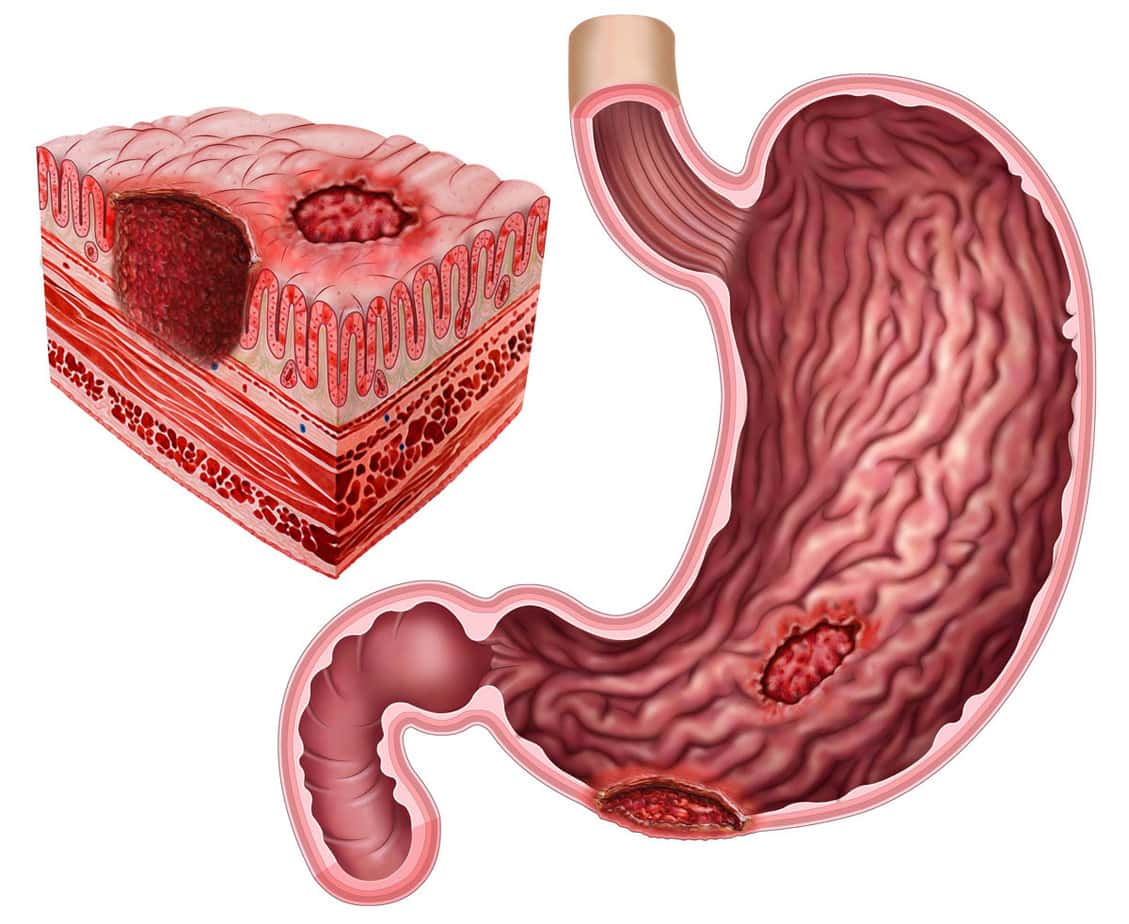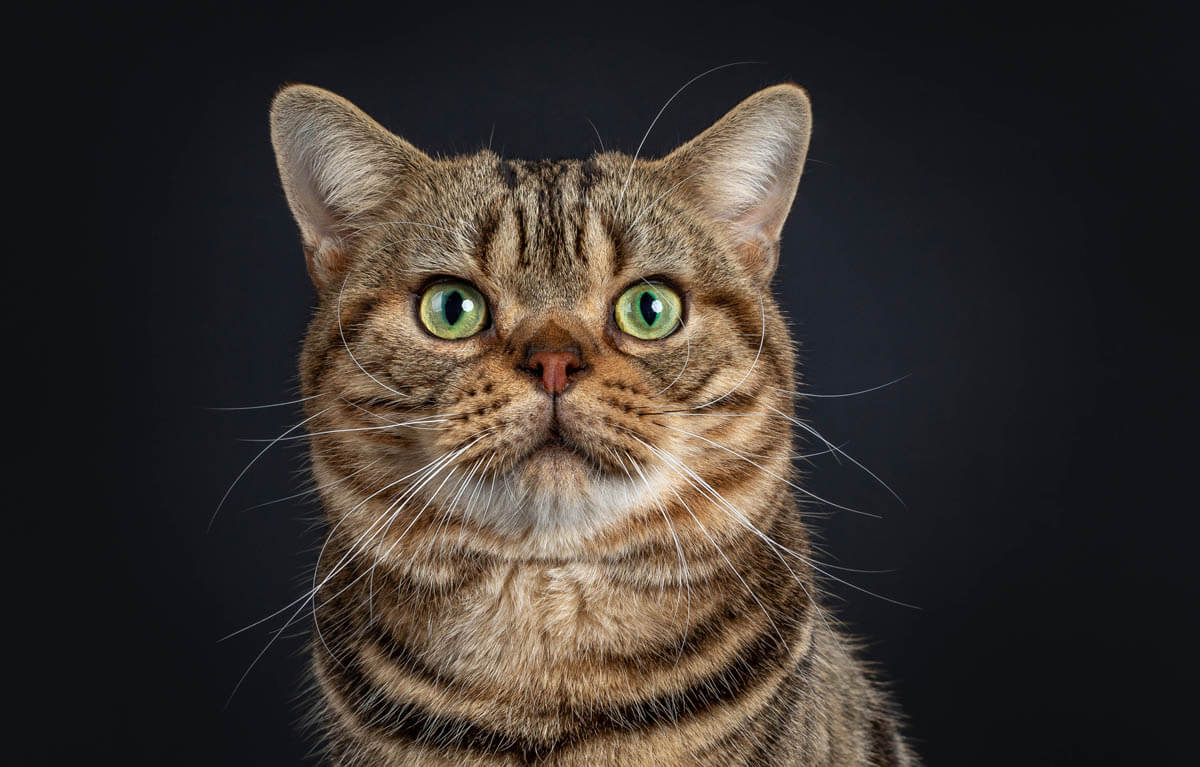At a glanceAbout: A gastric ulcer is a sore (or erosion) that develops in the esophagus, stomach or small intestine mucosa as a result of excessive exposure to stomach acid. Causes:
Symptoms: Can include vomiting, weight loss, dark stools, loss of appetite, pale gums, rapid heart rate, pale gums and abdominal pain. Treatment: Address the underlying cause and manage symptoms which will include stomach protectants and medications to reduce stomach acid production. |
What is a stomach ulcer?

Gastric ulcers (peptic ulcers) are open sores that develop in the deep layers of the stomach lining and small intestine which occur due to exposure to the stomach acid (hydrochloric acid) and digestive enzymes which are required for the digestion of food.
Usually, the gastric mucosa, a thick mucus layer, protects the stomach and duodenum from acids and digestive enzymes. If this barrier breaks, stomach acids, and enzymes can penetrate the deep layers and damage the underlying tissue. Untreated, the ulcer can eventually burn through the entire wall of the stomach allowing digestive juices to enter the peritoneum.
Causes
Several hormones are responsible for triggering the production of stomach acid including acetylcholine, gastrin, and histamine. Ulcers develop when there is an increase in the production of stomach acid or when there is a breach in the protective mucus barrier. Below are common causes of gastrointestinal ulcers in cats:
- Increased production of stomach acid overwhelms the protective mucus barrier. Gasgtrinomas and mast cell tumours can cause this.
- NSAIDs such as ibuprofen and aspirin
- Corticosteroids
- Ingestion of poisons such as antifreeze, plants or other caustic substances
- Stress associated with surgery and recovery
- Inflammatory bowel disease
- Gastrointestinal parasites
- Gastrointestinal obstruction due to tumours or foreign bodies
- Helicobacter pylori is a bacteria that is a cause of ulcers in humans. Infection has occurred in cats; however, there is no conclusive data to link the bacteria with ulcers in cats. One recent study did suggest a link between H. pylori and gastric lymphoma in cats.
- Liver disease
- Pancreatitis
- Addison’s disease
Ulcers can occur in cats of any age, and there appears to be no breed or gender predilection.
Symptoms
Not all cats with gastrointestinal ulcers will have clinical signs. When they are present, they are typically the following:
- Vomiting (sometimes with blood in the vomit or the appearance of coffee grounds)
- Unexplained weight loss
- Loss of appetite
- Abdominal pain
- Dark tarry stools (melena)
- Pale gums due to anemia (low red blood cells)
- Rapid heart rate
- Increased salivation
- Fatigue
- If the ulcer perforates, extreme pain, abdominal distension due to pneumoperitoneum (gas within the abdominal cavity), depression and collapse may occur due to septic peritonitis. A perforated ulcer is life-threatening and requires immediate treatment.
Other symptoms relating to the underlying cause may also be present such as increased thirst and urination in cats with kidney disease.
Diagnosis
Your veterinarian will perform a complete physical examination of your cat and obtain a medical history from you including symptoms you have observed, how long they have been present, any medications your cat is on and possible exposure to toxins. He will need to perform some tests which may include:
Baseline tests: Biochemical profile, complete blood count, and urinalysis to evaluate the overall health of your cat and check kidney and liver function. If your cat has an underlying condition, abnormalities may show up on these results which can help your veterinarian to narrow down a possible cause. Anemia is a common finding in cats who have ulcers.
Abdominal ultrasound and/or x-ray: To look for any blockages, foreign objects or tumours.
Fecal analysis: A fecal sample will be analysed for the presence of blood, bacteria, and parasites.
Endoscopy: A plastic tube with a camera will be inserted through your cat’s mouth and into the intestinal tract and stomach while under anesthesia. Biopsies may be taken at this time.
Upper gastrointestinal barium series: This test is performed see the upper GI tract and stomach. Barium is a white powder that is not transparent to x-rays. The cat is fed a barium meal, which coats the GI structures. An x-ray evaluates the coated structures for tumours or ulcers.
Treatment
The goal of treatment is to address the underlying problem where possible and protect the cat’s GI tract and stomach from further damage.
Treatment may include the following:
- Medicines to reduce stomach acid such as cimetidine, ranitidine, famotidine or omeprazole prevent further damage and also allows your cat’s GI tract or stomach to heal.
- Sucralfate is a medication that forms a gel-like consistency in the acidic stomach, covering the ulcers and preventing further damage to the already eroded tissue.
- A bland diet to rest the gastrointestinal tract.
- In some cases, surgery to cut out ulcerated areas or tumours in some cases.
- Dual antibiotics may be prescribed if your cat is infected with H. pylori.
- In cases where severe bleeding has occurred, your veterinarian may need to give your cat a blood transfusion as well as fluid therapy.
- If the ulcer has perforated, gastric resection is necessary; this involves surgical removal of the damaged part of the stomach followed by repair.
The prognosis is good if it is possible to treat the underlying cause, however it is poor for cats with gastric cancers or those who have developed sepsis.

